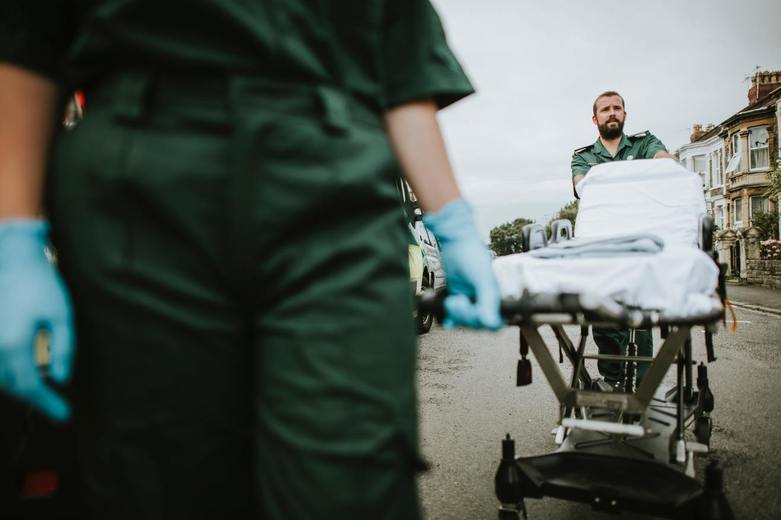If you have ever watched your FPIES child throw up over and over until they go limp and gray, you know how scary food reactions can be. One of the hardest and scariest things we had to figure out when my daughter was first diagnosed with FPIES was when a food reaction could turn into an emergency situation. So how do you know when to ride out symptoms at home, and when to go to the ER for an FPIES reaction?**
Food Protein Induced Enterocolitis (FPIES) is a type of food allergy that can cause gastrointestinal issues such as repeated vomiting and diarrhea. When a trigger food is eaten that causes an intense reaction, it can potentially cause the affected person to go into hypovolemic shock or become severely dehydrated from a sudden loss of bodily fluid. Some symptoms to watch for are: profuse, rapid vomiting and or diarrhea, vomiting up bile, extreme and sudden lethargy, and gray or very pale, clammy skin tone and appearance.
** First, I will put this disclaimer here: I am not a doctor, nor do I have any medical training. This is information based on what we have been told by our medical team, and what I’ve heard from other FPIES parents, plus what we have learned from experience and trial and error. Every single child with FPIES is different, and you will have to figure out your child’s reaction pattern and work with your medical team to figure out when you should manage symptoms at home and when you need to head to the ER. This information should be used as a guide – you know your child and you have a parental instinct that no internet article can give you. Trust that above all else.
That being said, I wish there had been information like this available when we were starting on this journey, because I didn’t know what vomit to shock meant and I had no clue what I was looking for. I had a group of FPIES moms to reach out to, but in a situation where you need to make fast decisions and every moment counts, I wish I had known in advance what to look for.
Symptoms to look for:
- Profuse vomiting or diarrhea
Out of the two of these, vomiting can lead to dehydration and shock much faster, but that doesn’t mean diarrhea can’t cause issues as well.
There is something uniquely scary about watching a child or baby have an acute vomiting reaction. The vomiting starts and then just doesn’t stop until there’s literally nothing left. For us, it came in waves. There would be one wave of vomiting with 8-10 vomits. Then, a few minutes of a break, usually five minutes or so. This would be followed by another wave of vomiting, followed by a small break. It would go on until there was nothing left to throw up except what looked like clear or yellow/green mucous. This is bile, and if you start to see this you might need to prepare to go to the hospital.
For us, it took about 2 hours from the first vomit until onset of dehydration/shock. But, the terrible thing about FPIES is that it can be different for every child. I’ve heard of kids who would consistently go into shock within 30 minutes of the first wave of vomiting. Some kids start vomiting in one constant wave of 10-15 vomits in the first thirty minutes with no break. You will probably need to watch your child and try to figure out the pattern of how their reactions progress so that you know when you might be dealing with an emergency situation.
Diarrhea can also cause dehydration and may cause children, especially smaller babies, to need IV fluids. Signs to watch for here are lack of wet diapers, lack of tears when crying, and chapped lips.
2. Extreme and sudden lethargy
This is the shock part of vomit to shock. This usually follows vomiting, we usually saw it after vomiting bile started. One minute my kids would be finishing a wave of vomiting and the next minute they were falling asleep, almost like they were passing out in slow motion. Some kids have episodes with their eyes rolling back in their heads and it looks like they are passing out. This isn’t just a normal tired like what you would get with a stomach virus, although vomiting like that is completely exhausting. This is a deep sleep/lethargy that is hard to rouse your child from, and if you are able to wake them up they seem really out of it and physically can’t stay awake.
If they vomit a lot and then drift off to sleep after but you can still wake them easily and they don’t seem confused, you might be ok. If they can keep down fluids you might be alright as long as you can get fluids back in them pretty steadily. However, if your child falls asleep suddenly, looks like they’ve passed out, or doesn’t wake up when you try to wake them, you probably need to call 911 or head to the closest emergency room. Personally, I would always err on the side of caution and just call for an ambulance. Things can go bad really fast if your child goes into shock, especially if your child tends to get dehydrated and go into shock really quickly.
3. Your child turns gray or pale and clammy
This comes along with shock symptoms, and usually happens around the time that the child goes into a deep sleep or passes out. This is a picture of my daughter during a vomit to shock reaction. Her body temperature dropped, she got cold and sweaty, and she fell asleep and was very hard to wake. After the reaction passed, she was up and playing and happy within a few hours. 
4. Lowered heart rate or body temp, shallow breathing
These are also signs that you need to get some extra help ASAP. Don’t mess around with it, call an ambulance. One of the first things they can do in triage or in an ambulance if you call for one is to start using a pulse oximeter. This will tell the emergency crews how much oxygen your child is getting and can help them get an idea of how serious things are.
Some tips to help you based on things we learned:
-If your child is profusely vomiting, do NOT try to drive them to the hospital.
Call an ambulance.
This may seem like an unnecessary step, but when you lay a child down in a car seat, especially the reclining infant carriers, they can choke or aspirate on their own vomit. This is especially true with FPIES when kids start vomiting repeatedly and there’s no break.
Plus, have you ever tried to clean puke out of a car seat? Trust me, you don’t want to do that. The smell is really hard to get out.
-Print and take an ER letter with you to the emergency room.
This is a letter that your doctor can write, or you can write it and have them sign it, stating exactly what diagnosis your child has and what needs to be done to stop the reaction. When my kids were first diagnosed, the standard advice was to start IV fluids asap and to get zofran in their system. The zofran can stop the vomiting and the fluids help reverse the dehydration. Some things have changed now – zofran will still stop the vomiting in most cases, but not all doctors will prescribe it or use it on children so small. Having a letter from your doctor with specific directions for your child is especially helpful because the instructions are tailored to your situation.
Make sure your letter has all of the important information needed: your doctor’s name, phone number, and your child’s diagnosis and treatment plan. The letter can also list the child’s major food triggers (this can help ER doctors decide which medicines could be safe for your child) and provide a list of medicines they react to and safe medicines to try. There’s an excellent sample letter on the i-FPIES website that your doctor can customize or just sign for you.
-Share your action plan with anyone who might be caring for your child
If you have a child that reacts and goes into shock really quickly, a daycare teacher or babysitter may not have time to see that your child is vomiting and call you to come get them. If the plan is for them to call for an ambulance right away, they need to know that and be prepared to do so. We always let our sitters know that if our kids started vomiting, their first call needed to be to emergency personnel, and the second call needed to be to me. I didn’t want them to even waste the 5 minutes it would take to call me first and risk my child going into shock with someone who didn’t know what they were looking for or how to handle it.
–Keep an ER grab bag packed and ready to go
We always kept a bag in our car and one in our house. Because reactions usually start several hours after the trigger food is ingested, you don’t always know when a reaction will happen. We kept a bag with several clean outfits, clean pj’s, diapers and wipes, an ER letter from our doctor, formula, pacifiers, and at least one clean bottle.
In the middle of a reaction, things can happen so quickly and violently that you probably won’t have time to run around grabbing things like extra diapers and clothes, but you will need these things if you have to go to the emergency room, or if your child is admitted to the hospital.

